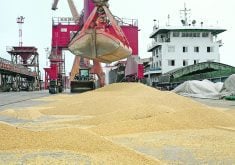The rhetoric on both sides of the Canadian Wheat Board debate has become totally overblown.
Extreme pro CWB advocates say that vast swaths of farmers will go out of business and Canadian consumers won’t be able to buy food with Canadian grown wheat if the single desk goes.
If the CWB was the only thing keeping your farm going it likely had no future anyway.
Even without the CWB single desk, Canadian farmers will continue to produce vastly more wheat than Canadians can consume and some of it will be processed at home into bread and bakery products for Canadians.
Read Also

Bunge’s crop mix is changing
Bunge has predominantly been a soybean processing firm, but that’s about to change after the merger with Viterra with softseed processing and grain merchandising gaining ground.
Equally fictitious are the tales of anti board advocates that ending the single desk will usher in a golden age for wheat farmers and processors with higher profits and increasing production.
A fair number of farmers will likely welcome a greater flexibility in how, when and to whom they sell their wheat but there will also likely be a fair number who preferred the single desk, don’t like the extra marketing effort and who will be frustrated by the inevitable disruptions while the grain handling system adjusts to the new environment.
But ending the single desk isn’t going to change the realities of the world wheat market where demand growth lags that of other crops.
In the 10 years between 2002-03 and 2011-12, global wheat consumption rose a paltry 13 percent.
In the same period global corn consumption rose by 38 percent and oilseed consumption rose 45 percent.
Is it any wonder that the canola market seems to produce better profits than wheat?
Corn went into the booming ethanol industry and increasing global livestock herds.
Much of the increase in oilseed demand came from China, which abandoned any hope of self-sufficiency in oilseed production but tenaciously tries to maintain a policy of grain self sufficiency.
Even rapid development of the South American soybean industry and the palm oil plantations of Malaysia and Indonesia were not enough to swamp the global hunger for vegetable oil and meal and biodiesel.
On the other hand, the countries of the former Soviet Union – Russia, Ukraine and Kazakhstan – stormed back into wheat production, flooding the slow growing market with cheap grain.
If it was not for the region’s devastating drought of 2010, and Australia’s run of droughts earlier in the decade, wheat prices likely would not have seen the rallies of 2007-08 and 2010.
What strength wheat prices have today is largely because they ride on the coattails of corn and oilseeds.
That is not to say there are no opportunities in wheat. Canada has been and will continue to be a major producer and global exporter
But when Conservative politicians say the sky is the limit for the western Canadian wheat industry, be aware that there is a fairly low cloud ceiling.














